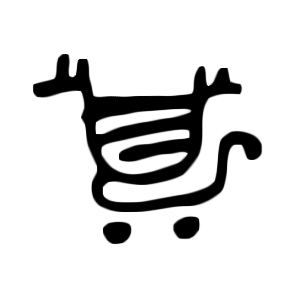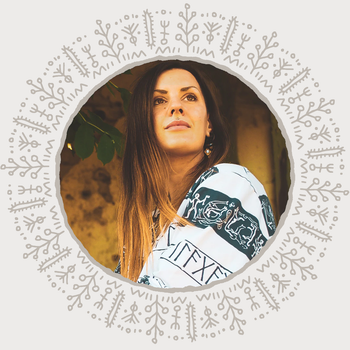Warriors of the Gods
← Back
Warriors of the Gods
The gods of Norse Mythology will not fight alone in the awakening of Ragnarök, they will have help from the mortal men and women from the realm of Midgard.
Einhärjar
“So spoke Ganglere: you say, that every one of the men, that since from the beginning of times and died by weapons, are now for Odin in Valhalla. What has he there, to keep them satisfied, because I think, that there certainly, must be a big amount of people there.
Then answered Hög (the high one): True is it, as you spoke, that there is a big amount of people there, and far many more will join in, but they seem still too few, when the wolf will arrive. However there is never too many in Valhalla, that they couldn’t get enough pork by the svine, who’s name is Sährimner: he is boiled ever day, and is still in one piece come evening. But on the question you are asking, I believe, that only a few are wise enough to answer. The chef is named Andhrimner, the cauldron Eldhrimner, and it is told:
Then answered Hög (the high one): True is it, as you spoke, that there is a big amount of people there, and far many more will join in, but they seem still too few, when the wolf will arrive. However there is never too many in Valhalla, that they couldn’t get enough pork by the svine, who’s name is Sährimner: he is boiled ever day, and is still in one piece come evening. But on the question you are asking, I believe, that only a few are wise enough to answer. The chef is named Andhrimner, the cauldron Eldhrimner, and it is told:
Andhrimner puts down in Eldhrimner
Särhrimner to be boiled,
the best of pork, that they’ve heard of
where the Einhärjar are being fed”
Gylfaginning Stanza 38
Särhrimner to be boiled,
the best of pork, that they’ve heard of
where the Einhärjar are being fed”
Gylfaginning Stanza 38
It is written down time and time again in the Eddas about the Einhärjar, the champions of Odin. Before the halls of Valhalla is where their beginning takes shape.
To become a champion for Odin you first need to be picked up from the battlefield one way or the other, or if you were “unlucky” not to die the heroes-death on the battlefield there were rituals to be held in order to make up for it. Like placing miniatures of weapons into graves and throwing spears in honour of Odin.
The Einhärjar were picked up by the Valkyries from the battlefields. Valkyries were female beings, sent out by Odin and at times Freyja. The Valkyries brought the fallen brave warriors to Valhalla (and Freyjas hall Sessrumnir). The ones entering the halls of Valhalla would become Einhärjar.
As mentioned in Snorri’s Gylfaginning, the halls of Valhalla are equipped enough to keep them fed and has more than enough room for them. There are 540 gates in Valhalla and each gate fits around 800 Einhärjar at once. Valhalla in other words is pretty huge, which is needed, since the warriors probably still keeps gathering up throughout all ages of war.
Every morning the Einhärjar puts their armours on and collects their weapons and then they gather outside of the hall. Outside they start beating the crap out of each other. Limbs, blood and even heads are flying, it is a game of “last man standing wins”.
Come evening, all of the limbs start assembling again with their correct owners and the warriors are as good as new again. Then it is time to feast with their fellow Einhärjar until the next morning. Every day they get better and better at battling.
To become a champion for Odin you first need to be picked up from the battlefield one way or the other, or if you were “unlucky” not to die the heroes-death on the battlefield there were rituals to be held in order to make up for it. Like placing miniatures of weapons into graves and throwing spears in honour of Odin.
The Einhärjar were picked up by the Valkyries from the battlefields. Valkyries were female beings, sent out by Odin and at times Freyja. The Valkyries brought the fallen brave warriors to Valhalla (and Freyjas hall Sessrumnir). The ones entering the halls of Valhalla would become Einhärjar.
As mentioned in Snorri’s Gylfaginning, the halls of Valhalla are equipped enough to keep them fed and has more than enough room for them. There are 540 gates in Valhalla and each gate fits around 800 Einhärjar at once. Valhalla in other words is pretty huge, which is needed, since the warriors probably still keeps gathering up throughout all ages of war.
Every morning the Einhärjar puts their armours on and collects their weapons and then they gather outside of the hall. Outside they start beating the crap out of each other. Limbs, blood and even heads are flying, it is a game of “last man standing wins”.
Come evening, all of the limbs start assembling again with their correct owners and the warriors are as good as new again. Then it is time to feast with their fellow Einhärjar until the next morning. Every day they get better and better at battling.
Svinfylking
Svinfylking is actually an offensive battle strategy used during Scandinavian Ironage and by (amongst others) the Vikings. The old Norse word “Svinfylking” translates into “Boar snout”, and if you look at the formation of this technique you’ll see why.
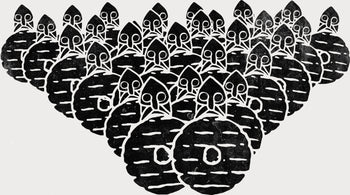
The Svinfylking formation, with two warriors in the front followed by rows of other warriors in a triangular shape to penetrate the enemies lines
It was said to be just as powerful as an angry boar. The triangular shape of the middle formation was a successful tactic to break through the enemy’s armies. So why are we writing about this historical tactical move in this blogpost about the warriors of the gods?
There are several indications that boars have played a huge role during Scandinavian Iron Age, and they are often times found in connection to war and warriors. Even though the tactical move Svinfylking isn’t a type of warrior per se, it tells us a story about how much these animals were connected to war. The god Freyr is heavily connected to boars and has his own war-boar named Gullinbursti. There has been archaeological finds of iron age helmets decorated with boars, one very famous example of this is the Torslunda Plates. Where you can see boar-warriors getting ready for battle. As long with the Vendel Era helmet from the area that gave the period its name: Vendel. This helmet is decorated with a big boar that turns into a human face in the front. Maybe it could be linked depicting Freyr and Gullinbursti riding into battle?
There are several indications that boars have played a huge role during Scandinavian Iron Age, and they are often times found in connection to war and warriors. Even though the tactical move Svinfylking isn’t a type of warrior per se, it tells us a story about how much these animals were connected to war. The god Freyr is heavily connected to boars and has his own war-boar named Gullinbursti. There has been archaeological finds of iron age helmets decorated with boars, one very famous example of this is the Torslunda Plates. Where you can see boar-warriors getting ready for battle. As long with the Vendel Era helmet from the area that gave the period its name: Vendel. This helmet is decorated with a big boar that turns into a human face in the front. Maybe it could be linked depicting Freyr and Gullinbursti riding into battle?
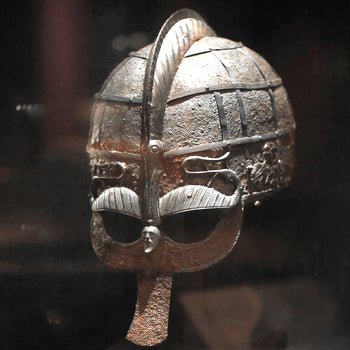
A boar figure running on top of the helmet to the noseguard, there are several other of these types of helmets with a boar figure on top or on the helmet
Vendel, Sweden
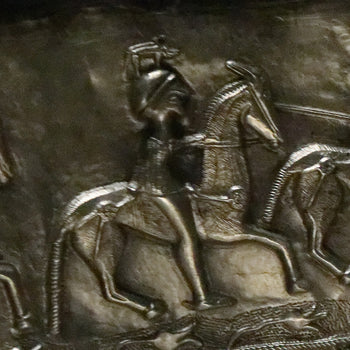
Figure wearing a boar on top of their helmet found on the Gundestrup cauldron
Gundestrup, Denmark
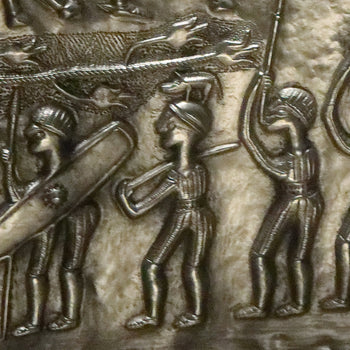
Another figure as well wearing a boar on top of their helmet also found on the Gundestrup cauldron
Gundestrup, Denmark
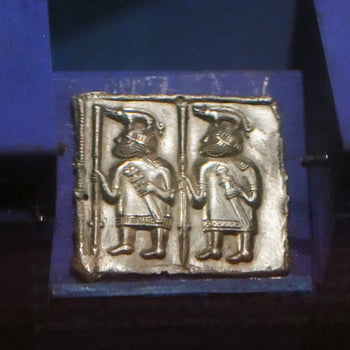
More examples of warriors wearing boars on top of their helmets from the Torslunda plates
Torslunda, Sweden
Berserkers and Ulfhednar
“I’ll ask of the berserkers, you tasters of blood,
Those intrepid heroes, how are they treated,
Those who wade out into battle? Wolf-skinned are they called. In battle
They bear bloody shields.
Red with blood are their spears when they come to fight.
They form a closed group.
The prince in his wisdom puts trust in such men
Who hack through enemy shields.”
Haraldskvæði, circa 9th century
Those intrepid heroes, how are they treated,
Those who wade out into battle? Wolf-skinned are they called. In battle
They bear bloody shields.
Red with blood are their spears when they come to fight.
They form a closed group.
The prince in his wisdom puts trust in such men
Who hack through enemy shields.”
Haraldskvæði, circa 9th century
The Haraldskvæði is a skaldic poem written by the Norwegian skald Þorbjörn Hornklofi during the 9th century. It is supposed to play out as a conversation between a raven and a valkyrie, talking about how brave and amazing Harald Fairhair was during his ruling. From this fragmented poem we find out about the berserkers and their character.
Berserkers are usually referenced to as “bear warriors”, since their name comes from the old Norse words for bear and shirt. It is also a reference to “going berserk” which is a mental state of going absolutely violently-war-crazy. Going so crazy that you wouldn’t care getting hit by an arrow or a spear, but just pushed on. Which can also be seen in Hornklofi’s poem, where the berserkers protecting the kings, princes and jarls is said to even before battle having blood on their armour and weapons, and having a reliable mentality where they would hack though shields of the enemy. The berserkers are usually also connected to animistic and shapeshifting rituals, where the lines between human and animal is theorised to have become blurred. There are also old sagas with examples of warriors turning into bears, as is the case with the saga hero Bödvar Bjarki. They are also sometimes depicted as biting their shields in a way of psychologically terrify their enemies, as with the depiction of berserkers in the Lewis chessmen find, dating to the 1100’s.
The ulfhednar are usually always connected to the berserkers, and sometimes it is hard to tell if they are the exact type of warriors side by side, if one could be both at the same time or maybe if they are different ranks of warriors. What is written down about the ulfhednar is however that they wear wolfskin (ulfhednar translates to wolfcoats), where the berserkers are usually depicted wearing bearskin. In the poem above the skald is mentioning warriors in wolfskins. The blurred lines between beast and man is also true for the ulfhednar. In Egil Skallagrimssons saga (circa year 850-1000) is a part telling the story of the man Kväll-Ulf. Ulf was a man from Fjärdafylke, Norway, that had gone viking together with his friend Kårem who is described as a berserker, and Ulf had thereafter become a wealthy man both in riches and children. He was also connected to Harald Fairhair, king of Norway. Ulf had a quirk however. Every evening the wise Ulf turned, and became incredibly aggressive and is described to have shapeshifted. The name Ulf is Norse for wolf, and Kväll-Ulf means Evening-Wolf. Archaeological finds of berserkers and ulfhednar can be found on the Torslunda plates as well.
Both berserkers and ulfhednar are also very much connected to Odin, both through finds and the sagas. In the Ynglinga Saga it is written:
“Odin could make it so, that in a battle his enemies would fall blind or deaf or filled with terror, as well as making their weapons not better than twigs; but his men falling forward without armour, and crazy as dogs or wolves, hitting their shields, were strong as bears or bulls and slaughtering men: but nor fire or iron affected them, which is called going berserk”
Ynglinga Saga, circa 1225, Snorri Sturluson
Ynglinga Saga, circa 1225, Snorri Sturluson
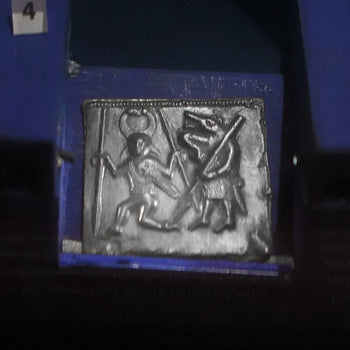
A figure wearing an animal pelt, likely a wolf - following what seems to be Odin, found on the Torslunda plates
Torslunda, Sweden
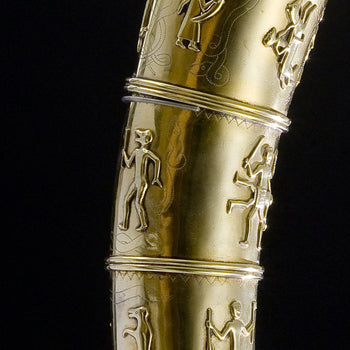
Likely an animal head figure on the golden horns from Gallehus, the horns feature several mythological beings and events on them
Gallehus, Denmark
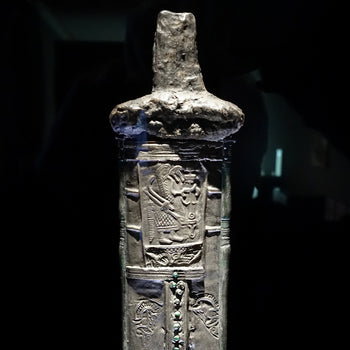
A 7th century Sword scabbard that features an animal pelt wearing warrior on it
Gutenstein, Germany
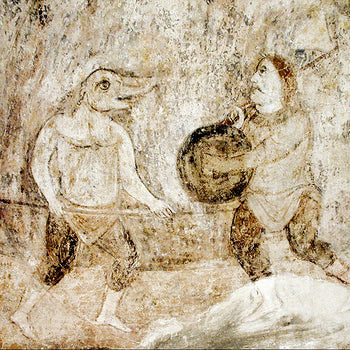
Fresco of what appears to be a berserker, found in Saint Sophia Cathedral in Kyiv. This area was inhabited by Varangians during that time who came from Scandinavia
Kyiv, Ukraine
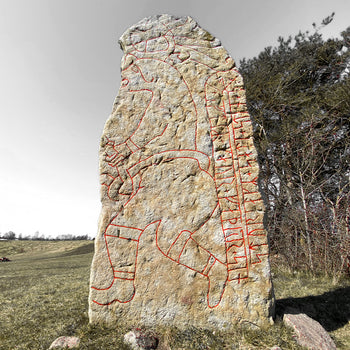
The runestone is said to depict perhaps a berserker, shaman, Thor with his mighty belt. It is hard to say as parts of it are missing, perhaps its a man fighting a snake that has bound itself around the man, as the top could be seen as a snake head as well
Källby (Vg 56), Sweden
Army of Helheim
Helheim is not only a horrid realm you’d never want to visit, but the biggest realm of the dead also serves a further purpose (than just being horrible to poor dead people and keeping the god Baldur hostage).
Since Hel is the biggest and most habited realm, there is no denying that creating an army out of all of these dead would be smart if there was ever a need. And a need there is indeed, but more about that is found further down in this post. By the Nastrabeach there is a huge ship being built, out of dead men’s nails. It is described as a huge dragon ship. This is the ship that will carry the army of dead until the last battle Ragnarök. Which means that if all of us make sure to groom properly we can hinder the ship from ever being finished.
The army of Helheim will be joined by Loki, Garmr, Jörmungand, and Fenrir at the day of battle. They will also have backup from the frost-jötunns coming out of Nifelheim, and Surtr with his fiery army coming out of Muspelheim. Right behind the backup is also all of the evil characters found in Norse Mythology like trolls, dragons, serpents, werewolves and other monsters.
Since Hel is the biggest and most habited realm, there is no denying that creating an army out of all of these dead would be smart if there was ever a need. And a need there is indeed, but more about that is found further down in this post. By the Nastrabeach there is a huge ship being built, out of dead men’s nails. It is described as a huge dragon ship. This is the ship that will carry the army of dead until the last battle Ragnarök. Which means that if all of us make sure to groom properly we can hinder the ship from ever being finished.
The army of Helheim will be joined by Loki, Garmr, Jörmungand, and Fenrir at the day of battle. They will also have backup from the frost-jötunns coming out of Nifelheim, and Surtr with his fiery army coming out of Muspelheim. Right behind the backup is also all of the evil characters found in Norse Mythology like trolls, dragons, serpents, werewolves and other monsters.
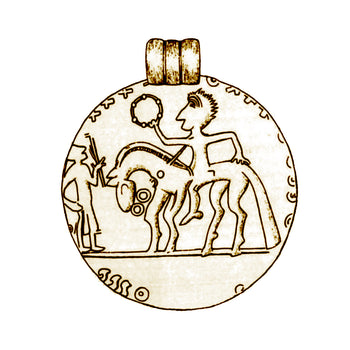
Hel has a couple of bracteates that have been suspected to be her by academics, this is one of them where a warrior is suspected to go to Hels realm (I think it's a reach but worth mentioning)
Stora Hammars, Sweden
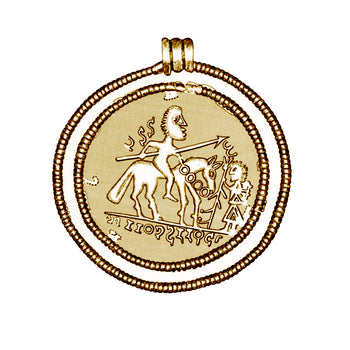
Another bracteate suspected to be Hel welcoming a warrior
Aneby, Småland, Sweden
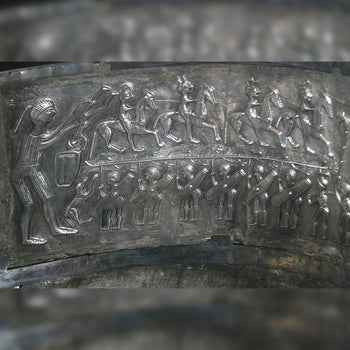
The same above mentioned Gundestrup cauldron, this scenery is similar to Hel receiving the dead with Garm guarding the entrance and her perhaps doing some ritual with these people she receives, afterall if you've died in battle and go to Hel I can imagine you're rather upset you didn't get chosen for Valhalla cause you werent a worthy enough warrior
Gundestrup, Denmark
Ragnarök
As earlier mentioned, these armies are well needed in the last battle, Ragnarök.
“Times of murder, times of storms,
then the world breaks.
The earth is rumbling,
jötunn women are flying,
no one shall
each other spare”
Völuspa, Stanza 49
then the world breaks.
The earth is rumbling,
jötunn women are flying,
no one shall
each other spare”
Völuspa, Stanza 49
Finally chaos and darkness will be cast upon the worldcreation, it is inevitable. The apocalypse of the Norse Mythology is named Ragnarök. But it doesn’t just something that happens overnight, it will creep up on both mankind and the gods. First there will be three very harsh winters in a row, where bitter wars will break loose in Midgard. These wars will be everyone against everyone, brothers turn on each other as well as fathers and sons. Humankind will become bitter, angry, violent and greedy. When this phase is over the eternal winter will come, the Fimbulvetr. This winter will last for three years straight and kill most living creatures with its ice-cold grip.
The next phase of Ragnarök is being introduced when Sköll finally catches up with the sun and swallows it whole. At the same time Hati will catch up with the moon and devour it. This leaves the ice-cold world in complete darkness. This is followed up by earthquakes caused by Fenrir, Garmr and Loki breaking their chains to finally once again be free. This will cause the midgardserpent Jörmungand to wake up, and destroy Midgard on his way up out of the sea, meanwhile Fenrir is swallowing big pieces of it with his big jaw.
Next up there is a rooster waking up all of the dead living in Helheim, and the huge dragonship Naglfar leaves its port soon enough. When the army of Helheim, Muspelheim and Nifelheim marches against Asgard the huge rainbow bridge Bifrost breaks. Meanwhile Heimdallr has already blown the gjallarhorn to warn the gods, valkyries and elves of the upcoming war. Everyone gets ready for the last battle. Ragnarök is the ending of most of the gods and their evil enemies. Odin dies battling Fenrir, which becomes slain by Vidarr avenging his father. Thor successfully defeats Jörmungand finally, but also dies after the huge serpent has poisoned him during the battle. And poor Freyr doesn’t have his magical sword when Ragnarök happens, so he bravely puts up a fight against Surtr, who becomes the death of Freyr. Garmr and Tyr kills eachother, as well as Loki and Heimdallr both kills each other after an epic duel. At the end of the battle Surtr breaks the world open with his huge fire-sword. And the world once again turns into the same chaos and nothingness as in the time before time, when the nothingness Ginnungagap was everywhere.
Don’t worry however! The worldcreation will finally once more rise up from the fire, chaos and seas, purified from Ragnarök’s evils. The sun will once more rise up on the sky and the world wont be drowned in darkness anymore. Even though many of the gods dies during Ragnarök, it is far from all of them that does. As you might remember; Vidarr avenged his father Odin and killed the giant wolf Fenrir off. He survives Ragnarök until the new world. Thors sons Modi and Magni survives as well, as well as Odin’s other son Vali. And since Helheim has been left unattended and next to empty, both Hödur and Baldur escapes from there to join their brothers in the pursuit of rebuilding Asgard. The world-tree itself has survived, Yggrasil has hidden away two creatures from Midgard, so even two humans made it. Liv and Livtrasir.
It is not only gods and humans that has survived Ragnarök, also the evil Nidhöggr is still alive and is predicted to be the cause of the next apocalypse.
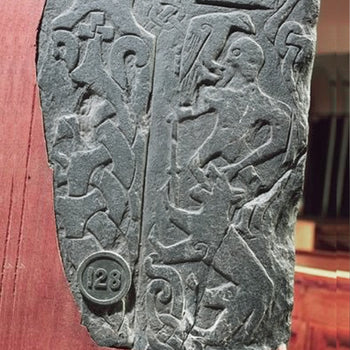
This is the Thorwald's Cross and it's suspected to feature the scene of Fenrir swallowing Odin, we can see a bird which appears to be a raven on the mans shoulder - which Odin was known for having two ravens, the figure of the man is also holding a spear which Odin is known to have a spear named Gungnir and is often associated with spears as well as during Ragnarök the wolf is said to swallow the allfather. Likely from around 900-1100
Isle of Man
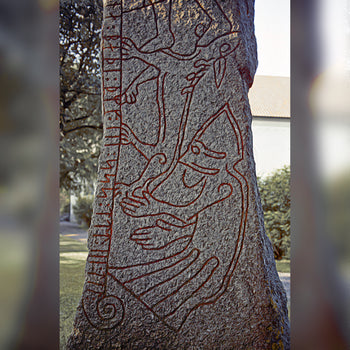
Relying on the previous mentioned depiction we see a similar motif in this one, a wolf seems to be swallowing a fella. This could just depict some kind of event from that area or a story that is now lost to time, but there is definitely some similarities here. At the end of the runic writing we can see the Tistel-Mistel-Kistel sequence which I've covered in our 'Learn the Runes' article in the magic section. This is dated to around the 1100s as well
Östergötland (Ög 181), Sweden
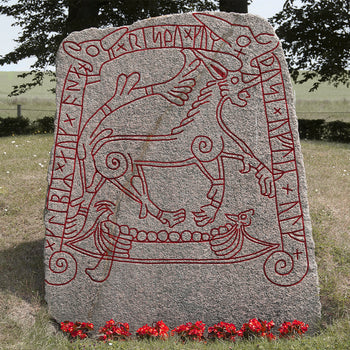
A possible depiction of Fenrir and the ship Naglfar. The runes on it read 'Kleppir and Ása raised this monument after Ulfr.' which also hints that this could be just associated with the person, as Ulf means Wolf in Scandinavian languages. If it is the ship and Fenrir, then this is a possible depiction of Ragnarök when Fenrir gets freed and the ship sets sail
Tullstorp (DR 271), Sweden
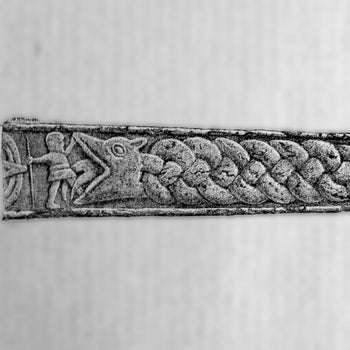
On the Thorwald's Cross there can be seen a depiction of a fight between a beast and a human figure. This has been depicted as Vidar slaying the giant wolf Fenrir. This is another event taking place during Ragnarök after Odin has been devouered by the giant wolf, it is Vidar who avanges Odin
Isle of Man
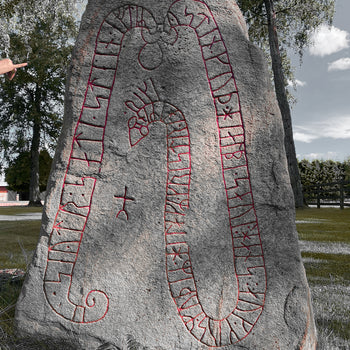
Eventhough the runes here don't hint at this being a specific pagan depiction, but if we rely on the serpent on runestones being the Midgard serpent then perhaps here it depicts the giant monster and the little figure is meant to be Thor. This could be interpreted when Thor during Rangarök fights the giant serpent
Vestergötland (Vg 186), Sweden
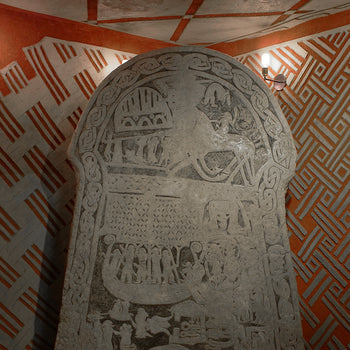
Many of the Gotland stones feature motifs from Norse Mythology, the ships could be seen as ships sailing in the underworld as well as figures seeing riding into and out of what is suspected to represent Valhalla, large armies and fights. These could also be personal tales of people and their raids, it is all up for interpretation
Gotland Runestones, Sweden
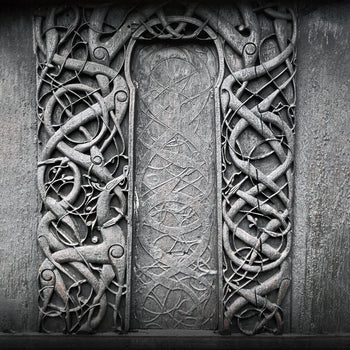
The stave church from Norway has been suspected to bear symbolism of Ragnarök, with its serpents and beasts featured on them.
Urnes Stave Church, Norway
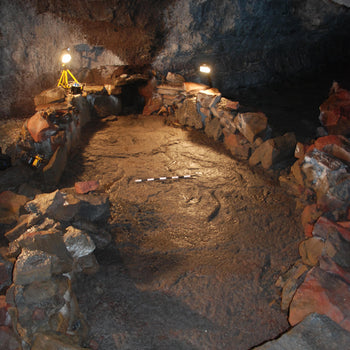
In Iceland there hides a lava cave known as Surtrs cave. Archaeological digs from there have found animal bones as well as offerings, in addition there are stones set in a shape of a ship as well as Landnámabók, written in the 12th-13th century mentions passages into this cave with rituals taking place. It is proposed that these offerings were made to please the fire Jotünn. Considering Icelands volcanoes are active the people living there might as well considered they are in touch with Surtr themselves and perhaps these offerings were to ward off Raganrök. I mean who wouldnt appreciate a buncha oxen and nicely craft jewelry, everyone likes shingy things
Surtshellir, Iceland
Final words!
I hope you enjoyed this post about a very grim and dark topic. It is however cool to know that humans during many different ages believed that there is more to death and life than we would ever expect. Hopefully we won't have to live through any Fimbulvetr soon.
Take care friends! – Elin aka MooseLady
Take care friends! – Elin aka MooseLady
What to read next?
Leave a Comment
Read what others say
2 COMMENTS
David
Nov 25, 2025
Well done, thank you for making this site.
Angelika Beba
Aug 19, 2024
Sehr interessant und gut verständlich zu lesen… Danke


